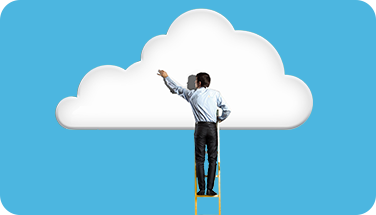Now is the time to start the modernization journey
In an era of rapid digital transformation, organizations that rely on on-premises ERP systems are facing increasing challenges. What was once considered "adequate" is now seen as outdated, inefficient, and costly.
According to the 2024 IDC Infobrief - Maximizing Your ERP Transformation through Cloud Migration, 70% of organizations reported that their on-premises ERP systems met their needs in 2021.

By 2024, that number had dropped to just 38%, highlighting a growing frustration with legacy ERP systems and their inability to support the evolving demands of modern businesses.
“Modernizing with a move to Cloud is a critical step in limiting your exposure to the growing risks and costs of maintaining a last-generation ERP system.” IDC Infobrief 2024.
Organizations that fail to modernize risk falling behind competitors who are leveraging Cloud-based ERP systems for greater flexibility, efficiency, and innovation.
What’s driving the shift to Cloud ERP?
Businesses today are navigating a world of relentless change. Several key factors are accelerating the move away from on-premises ERP systems:
Regulatory changes
Governments and industry bodies are imposing stricter compliance requirements, including eInvoicing standards and ESG (Environmental, Social, and Governance) reporting obligations. Companies need modern ERP systems that can seamlessly adapt to these regulatory demands.
The continued rise of hybrid and remote work
Flexible working models require Cloud-based systems that ensure employees can securely access critical business functions from anywhere in the world.
Security and compliance concerns
As cyber threats grow in sophistication, businesses need ERP solutions with robust, built-in security measures to safeguard sensitive data and ensure regulatory compliance.
Supply chain disruptions
Recent global events have exposed vulnerabilities in traditional supply chains. Modern ERP systems provide real-time visibility and agility, allowing businesses to respond swiftly to disruptions.
AI and automation
Companies are increasingly looking to artificial intelligence (AI) and automation to improve efficiency, reduce manual workloads, and optimize decision-making.
Evolving customer expectations
Consumers and businesses alike demand real-time access to services, faster response times, and personalized experiences. Legacy ERP systems often lack the agility to meet these expectations.
The risks of holding onto legacy ERP systems
Maintaining an outdated ERP system isn't just an inconvenience—it’s a growing liability. According to the IDC Infobrief 2024, “the costs and risks of doing nothing are real and only increase over time.”
Organizations relying on legacy systems face increasing risks, including:
- Escalating maintenance costs – Keeping outdated systems running requires significant financial and human resources, diverting budgets away from innovation.
- Talent shortages – IT professionals skilled in legacy ERP platforms are becoming harder to find, leading to operational risks and higher staffing costs.
- Fragmented operations – Older ERP systems often consist of disparate components patched together over time, creating inefficiencies, communication gaps, and operational bottlenecks.
- Data silos and limited insights – Legacy systems struggle to deliver real-time data insights, making it difficult for business leaders to make informed, strategic decisions.
- Security vulnerabilities – Outdated ERP solutions are more susceptible to cyber threats, increasing the risk of data breaches and compliance failures.
- Inhibited growth and innovation – Businesses looking to expand or adopt emerging technologies may find their legacy systems unable to support these ambitions.
Cloud migration: A strategic imperative
Migrating to a Cloud-based ERP system isn’t just a technological upgrade—it’s a strategic transformation that drives business growth and resilience. Cloud ERP offers significant advantages:
- Reduced risk and increased security – Cloud-based ERP solutions benefit from continuous updates, ensuring the latest security features and compliance measures are always in place.
- Access to innovation – AI-powered automation, predictive analytics, and machine learning capabilities are seamlessly integrated into modern Cloud platforms.
- Enhanced operational efficiency – Automation and process streamlining free employees from repetitive tasks, enabling them to focus on higher-value work.
- Optimized IT spending – Cloud ERP eliminates the need for costly on-premises infrastructure, reducing long-term maintenance expenses.
- Greater agility and scalability – Businesses can rapidly scale their ERP systems in response to growth, market shifts, or evolving customer needs.
- Seamless system integration – Cloud-based ERP enables better integration with other digital tools, such as customer relationship management (CRM) platforms, HR systems, and financial applications.
Why now is the right time to act
The longer organizations delay ERP modernization, the harder it becomes to keep pace with industry shifts. Companies that take proactive steps now will be in a stronger position to:
- Implement a scalable, adaptable ERP system that can evolve with business needs.
- Improve decision-making by leveraging Cloud-based analytics and AI-driven reporting.
- Enhance employee and customer experiences with a modern ERP system, delivering smoother workflows, better accessibility, and improved service capabilities.
- Increase resilience and adaptability. Cloud ERP allows businesses to pivot quickly in response to unexpected disruptions, competitive pressures, or regulatory changes.
Preparing for a successful Cloud migration
Transitioning to a Cloud-based ERP system requires careful planning and execution. Organizations should:
- Assess their current IT landscape – Conduct a thorough audit to identify inefficiencies, limitations, and opportunities for improvement.
- Define clear business objectives – Understand how Cloud ERP aligns with broader company goals, such as digital transformation, customer experience enhancements, or cost reduction.
- Select the right Cloud ERP provider – Choose a vendor that offers the features, scalability, and support necessary for long-term success.
- Develop a phased implementation strategy – Minimize disruptions by rolling out the new system in stages, ensuring employees have adequate training and support.
- Monitor and optimize post-migration – Continuously assess the system’s performance and make necessary adjustments to maximize efficiency and ROI.
Start your Cloud ERP journey today
Businesses that invest in AI, automation, and customer-centric strategies can’t afford to be held back by outdated ERP systems. Cloud migration isn’t just about staying current; it’s about unlocking agility, innovation, and long-term competitive advantage.
The time to act is now. By modernizing ERP systems today, organizations can build a resilient foundation for future growth and success. Don’t wait—take the first step toward digital transformation today.
How Unit4 can help on your Cloud journey
At Unit4, we understand that migrating to the Cloud is more than just a technology shift; it’s a transformation that impacts every aspect of your organization.
Our Cloud-based ERP solutions are designed to help people-centric organizations streamline operations, enhance agility, and unlock innovation. With built-in AI, automation, and advanced analytics, Unit4 ERP empowers teams to work smarter, not harder.
Whether you're looking to reduce IT complexity, improve financial management, or enhance employee and customer experiences, our solutions provide the flexibility and scalability needed to future-proof your business.
Check out our suite of integrated solutions here and see how Unit4 can guide you on a seamless, secure, and strategic path to ERP modernization. Or you can speak to sales here.






